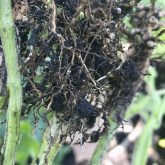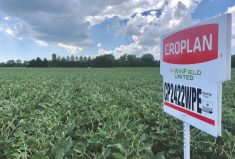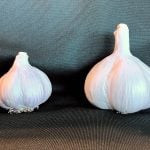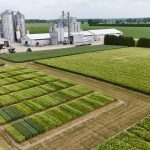With lower commodity prices looming over the grain and oilseed sector, more farmers this winter are asking whether that expensive bag of seed is really the smartest buy. At the very least, they say, it’s time for a fresh look at trait economics.
The companies that produce this seed charge top dollar for it, and when growers could get top dollar at the other end of the production chain, the math made sense. But with the erosion of crop prices, the return on investment from buying genetically modified seed has eroded too.
Read Also
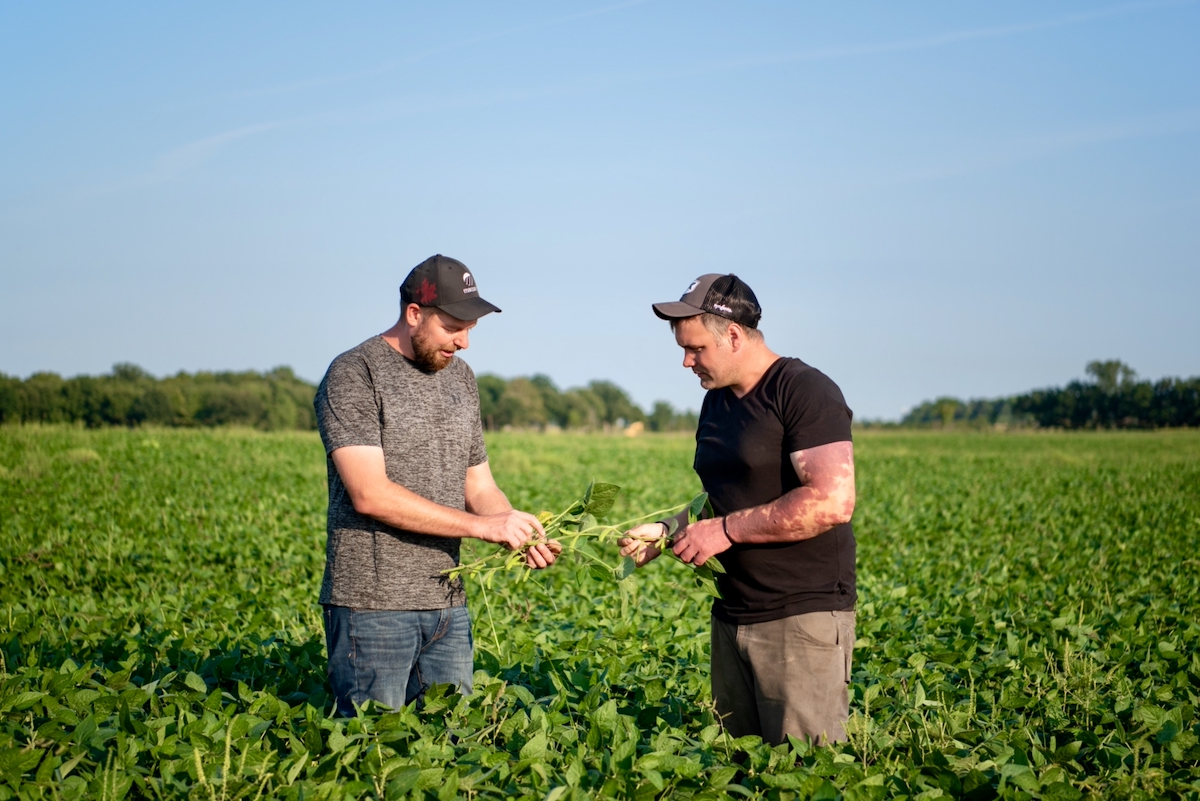
Ontario farmers partner for success
Ontario business partners, Matt Bergman and DJ Wassenaar, have been farming together for 10 years. Their focus on integrating unconventional…
It’s a big change in psychology.
Only a year ago, the question would hardly have made any sense. At the market’s peak, the lure of biotech was so strong it was tough to persuade growers to try anything else. Last spring at the London Farm Show, the price of soybeans was above $13 a bushel and dealers were testing growers to find a price point at which they’d grow non-biotech IP beans. Anecdotally, the premiums on offer were as high as $6.
To hear growers tell it, the premiums weren’t driven by the extra management requirements for an IP crop, or by the risk of not making grade at delivery. It was simply that growers thought they’d need that much to walk away from today’s effective and productive biotech systems.
- More Country Guide: On the rebound
So yes, there’s been some sticker shock with seed traits, says Shawn Brenneman, agronomic sales manager for Syngenta. “The cost of seed has gone up over years,” he agrees. “But when you look at it as a system, you have to look at the whole system, not just the price of the seed.”
This winter, biotech industry leaders are out there pitching biotech, and reminding growers of what it was like to grow their crops before the traits hit the market. These seed producers say they understand that farmers need to contain costs during times of tighter margins, but they also say it’s important to distinguish between cutting fat and making choices that will impair productivity and profitability.
Mike McGuire, president of Monsanto Canada, says Canadian farmers will continue to vote with their planters. He sees it as a kind of annual referendum on the cost-efficiency of the technology, and so far, farmers have delivered a ringing endorsement. Today 80 per cent of soybean acres and 90 per cent of corn across Canada are genetically modified.
If anything, McGuire says tighter margins make for a better business case for biotech.
“Think back to other times when we’ve seen a significant shift in commodity prices,” McGuire says. “History has shown us that people are more willing to make investments in technology when commodity prices go down.”
When commodity prices are low, the most cost-effective bushel is the winner, and frequently that means maximizing yields with judicious investments that spread operating costs over as many bushels as possible.
“You want to make sure you have the highest yields, you want to hedge your bet, and make sure you’re in the best protected position,” McGuire says.
In fact, history shows biotech adoption goes up when commodity prices are low, McGuire says. Once growers pencil it out, they tend to realize that they can actually maximize their potential with biotechnology, instead of cutting back on investments that maintain or grow productivity.
McGuire has spoken with enough growers during the winter meeting season to have heard any concerns, and he says he isn’t hearing a lot of negatives about the value of the technology.
The notion that growers might not be getting a fair return also falls on a cultural observation that McGuire makes about U.S. cropping practices versus those in Canada. In the U.S., growers tend to base more of their decisions on market conditions. In Canada, even with corn at $7 per bushel and up, most growers maintained their rotations in 2012 and 2013, understanding the long-term benefits of wheat and soybeans, and their effect on subsequent crops.
It may be that a three-crop rotation doesn’t provide the biggest return in terms of absolute cash returns, but it’s a more sustainable approach as it relates to overall production, soil health and maybe even cash flow — in the long run.
As for seed prices, McGuire notes that it isn’t always a matter of simply hiking the price of a bag of seed to whatever the traffic will bear. The companies generally do what they can to ensure the best value to the grower and a fair share accruing to both the company that undertook the expense and risk of developing the technology, and the farmer who’s adopting it in hopes of growing their own profitability, he says.
“We try to structure it so that it’s not always going to be a one-year phenomenon,” McGuire says. “If commodity prices go down or a weather event impacts growers, the company wants to make sure there’s space where, even in the toughest year, growers are still getting value for the technology.”
McGuire concedes in a tough year, yes, the value won’t be as high as in a year with high prices and high production, but the same is true of almost all farm technology. For the companies, keeping customers satisfied during bad times is at least as important, McGuire says. “We don’t want them to feel that they’ve made the wrong decision about the right technology.”
McGuire also says some farmers are beginning to approach company representatives with a bit of a counterintuitive question: they want to know what is the highest-priced seed the company has on offer. When questioned a bit about where they’re headed, these farmers explain that they’re looking for the best of the best, and they believe they can recoup that cost with higher production.
For growers pursuing this strategy, it’s basically an all-in game on crop inputs. An additional $40 or $50 for a bag of seed means they’ll want to do everything they can because a small problem that causes, say, a 10-bushel-an-acre yield hit on corn will put the grower underwater on the seed decision just about immediately.

No matter what corners a grower cuts — dropping a herbicide application, delaying tilling his ground for another year or two, or skipping the benefits of biotech — not investing in the technology is problematic. The difference between varieties and hybrids from 2009 and those they’ll plant in 2014 are substantial enough that they’re already losing yield with those older varieties and hybrids. Then measure that against the very real fact that Canadian lines are producing quality yields in growing seasons that are shorter relative to conditions in the U.S. A few years ago, a 100-day growing season was needed to reach 200 bushels of corn; then it was 95 days, then it was 90 days. Last year, there was a report of a grower in Manitoba who yielded 200 bushels with a sub-80-day hybrid. Rolling the clock back to older hybrids that don’t include biotech traits leaves those gains on the table.
For Doug Alderman, national sales manager for Pride Seeds, the question to growers is whether they’re talking about the return on investment as it relates to the economics of purchasing the seed, or is it the return in terms of getting more “bang for the buck” for the Roundup trait? Or is it a straight “cost-of-seed” issue or perhaps even the cost of the system, with the value of the herbicide factored into the equation?
Alderman points out that there’s no one forcing growers to use Roundup Ready technology — or LibertyLink, SmartStax or any of the others. Farmers are using it because it works, they’re finding value in it and they’ll make any adjustments they have to on their operations in order to secure their annual supply of this technology for their farms.
“There’s a mound of benefits, from convenience to simplicity to the fact that it just works,” says Alderman. “In the end yield is king, and I question that without that technology, where we would have been as an industry, in terms of yield.”
Consider the drought in 2012, and what biotech traits and the latest genetics meant to growers. Without the right germplasm turned into hybrids and varieties, farmers would not have seen soybeans yielding into the 60s and corn yielding well above 150 as an average despite the obvious and pressing production constraints that season.
“It doesn’t matter how you cut it, the return is there,” says Alderman. “Now, if an individual questions whether it’s for them, whether they’re getting the yield out of that for the sake of what they’re spending in a particular cropping system — with seed and chemicals — it begs the question: ‘Why?’”
Alderman says he’s convinced in those cases there’s likely an underlying issue hampering yield that’s unrelated to the genetics, which will do their job, given half a chance.

With the advent of trait development and biotechnology, one of the management practices that has become successful for growers has been the widespread adoption of no-till and reduced-till systems.
Syngenta’s Brenneman says it’s important to view the technology as part of a larger system with trade-offs throughout that contribute to its overall productivity.
The bottom line for a bag of seed today is actually comprised of a number of different components, and the actual cost of seed is just one of them. For example, there’s the cost of seed treatments and inoculants, which are already contained in each bag of seed. Then there’s the value of the genetics themselves, and the value of the biotechnology component. All this can add up, but it’s important to note they’re there if a farmer is stacking this price up against another production system that doesn’t include them.
Brenneman concedes there can be some initial sticker shock, but he maintains that included in that price is the service — be it for seed treatments or inoculants. It’s all part of the price of a bag of seed, and he believes most growers see the value, and that independent trials support the value of these investments.
“Some of the work done by the Ontario Ministry of Agriculture and Food (OMAF) indicates variety or hybrid selection in soybeans and corn is really the No. 1 choice for growers to maximize yield,” Brenneman says.
Brenneman also points out part of the cost of the bag of certified biotech seed is reinvested back into the research and development pipeline, something that’s often overlooked and undervalued. And a quick check of the wheat sector shows that yields haven’t increased to the same degree as in corn and soybeans. Much of that can be attributed to biotech innovations.
“Have we seen the advancements in wheat that we have in other crops?” ask Brenneman.
For Jim Wispinski, president of Dow AgroSciences Canada, the bottom line on the debate comes down to the individual farmer and the benefits brought to market by biotech innovation. In Canada, corn, canola and soybeans have been the beneficiaries of the development of genetic modification. That has facilitated private sector investment in plant breeding and increased yields substantially.
“Contrast that with the crops that have not attracted the investments for various reasons, and in those other crops, the yield increases have lagged,” says Wispinski.
Wispinski adds that as an industry, everyone is better off because of that research, but investing in those technologies is expensive. In the end if the numbers don’t make sense, farmers will figure that out.
“Farmers are great business people,” Wispinski says. “They make return decisions on every input cost, just like all of us in business. We’re all hard-nosed about input costs, and trying to get those down if we can. But we’re also making our purchase decision based on whether they provide a return versus the alternatives. And clearly the farmers are answering, ‘Yes.’”
This article first appeared in the 2014 Soybean Guide







